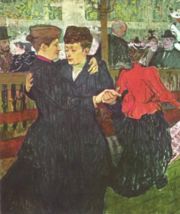Modern Art

Luncheon on the Grass by Pablo Picasso

Au Moulin Rouge: Two women waltzing by Henri de Toulouse-Lautrec, 1892

Fountain by Marcel Duchamp, 1917

Campbell's Soup cans, synthetic polymer paint on thirty-two canvas Each canvas measuring 50.8 x 40.6 cm, by Andy Warhol, Museum of Modern Art, New York, 1962
It is generally assumed that the modern art began in 1907 with Les Demoiselles d'Avignon by Pablo Picasso and ends in the mid 1960s with the onset of movements Fluxus and Pop Art roots of art Current and vocabulary of art says contemporary art. Modern art is distinguished in its commitment to independence and the birth of art criticism, in effect at that time the art became a topic of writing: the critical time is often initiated on the speech 'work. Goethe and Matisse write about color. Many artists publish texts or manifest (Dada, Futurism, Surrealism, etc..: Watch Movements in painting).
The advent of photography has influenced many artists of the nineteenth century and the twentieth century from Degas to Picasso, Matisse, Miró, and many others which will become the leading figures of modern art.
The concept of Modern Art
The term "modern art" is defined by both the style and choice of subjects. It features its own art of the first half of the twentieth -1905: years of scandal Fauves at the Salon d'Automne - but between 1950 and 1960 that the very term "modern" makes sense and is used to define a period.
The concept of modernity pervades art and institutions in the twentieth century, but it emerged in 1850 to describe the great changes in the nineteenth century from the technical and industrial revolutions. "Modernity" is a thinking, living and creating, which is resolutely based on new changes and reaction (as is always the case with major changes) to the time that preceded it. In The Painter of Modern Life, Charles Baudelaire finds beauty in the street and he sees changing, mobile in the modern artist, he welcomes the ability to deliver transitional daily eternal beauty.
At Walt Whitman, it is sensible to observe the impressive daily perpetual motion. The beauty is no longer the preserve of the old. Mass culture and popular entertainment crushes and signals the end of the excitement of the official morality. There are new subjects marked a new modernity, particularly in industry as in the case of Gare Saint-Lazare by Monet, where one finds little nostalgic look, and this is true modernity . The impressionistic touch, apparently, is different from the smooth touch that was previously put on the conventions of the time. There is also greater freedom in color. From an institutional perspective, the emergence of modernity undermines the Academy in its power to authorize or prohibit the entry of a work room. The jury rooms begin to lose their absolute credibility to the painters, the state and the public.
In 1863 at the Salon des Refuses, Napoleon III decided to "let the public judge alone, and is an outburst of laughter and sarcasm that has befallen The Luncheon on the Grass by Manet, it is very clearly clear what influence the jury has on public opinion. In 1884, the Academy no longer runs the Fine Arts and loses legitimacy in the eyes of artists such loss of authority favors the emergence of creation called "bohemian" and an art market where galleries actresses become the foreground. Painters' non-academy "finally refuse to be exhibited alongside the academies, and that is why the creation in 1885 the Salon des Independants in 1890 the Salon de la Societe Nationale des Beaux-Arts and the Salon Fall 1903.
The term "vanguard"
The concept of avant-garde is claimed by the artists in their priority to research and innovation, in direct continuation of World's Fairs in 1851 and a quasi-simultaneous. This new statement is consistent with a complete break with the conventions: the conventional categories are shaken (oil on canvas painting, marble or bronze sculpture ,...) and lead artists of the twentieth century create new ones such as collages, assemblages, the ready-made, etc.. These are the "vanguard" (a term derived from the military vocabulary and that means a company generated and sent as a scout). L 'Avant-garde is not the act of a single artist, but rather a group that unites in defense production, the fight is a must for the dissemination of their new vision of the world. There is not a Vanguard but many consist of groups of artists more or less organized.
In 1936, Alfred Baar offers the Museum of Modern Art in New York an exhibition in which he sets up a genealogical table of Modern Art. It deals with the legacy of the Impressionists and grading is done now by most national school but by observation of an international movement for a period of five years in succession. The table clearly highlights the multiplicity of groups, their substitution decisions and the perpetual motion.
Chronological list of art movements of modern art
Before 1914:
New art: Gustav Klimt
Fauvism: André Derain, Henri Matisse, Maurice de Vlaminck
Cubism: Georges Braque, Juan Gris, Fernand Léger, Pablo Picasso
Futurism: Giacomo Balla, Umberto Boccioni, Carlo Carrà
Expressionism: James Ensor, Oskar Kokoschka, Edvard Munch, Emil Nolde
De Stijl: Piet Mondrian
Abstraction: Wassily Kandinsky, Kasimir Malevich
The period between the wars:
Bauhaus: Wassily Kandinsky, Paul Klee
Constructivism: Naum Gabo, László Moholy-Nagy
Dada: Jean Arp, Marcel Duchamp, Max Ernst, Francis Picabia, Kurt Schwitters
Surrealism: Salvador Dalí, Max Ernst, Rene Magritte, Andre Masson, Joan Miró
New Objectivity (Neue Sachlichkeit): Max Beckmann, Otto Dix, George Grosz
Postwar:
Figurative: Bernard Buffet, Jean Carzou, Yves Brayer, Maurice Boitel, Pierre-Henry, Daniel's Janerand, Jean Monneret, Gaston Sébire, Louis Vuillermoz, Claude-Max Lochu
No extras: Jean Bazaine, Maurice Esteve, Jean Le Moal, Alfred Manessier, François Baron-Renouard
The Abstract Expressionism or Action Painting: Mark Rothko: Willem de Kooning, Jackson Pollock
Art Brut: Jean Dubuffet
European figuration: Francis Bacon, Alberto Giacometti, René Iché, Marino Marini, Henry Moore